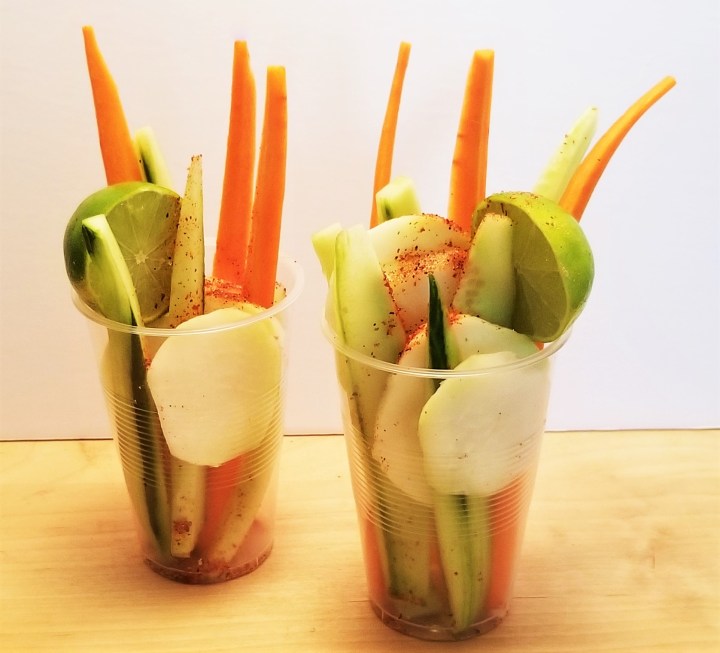
In the last couple of decades,“pico de gallo” has become identified with the emblematic Salsa Mexicana – Mexican Sauce, also known as Salsa Bandera – Flag Sauce, for its green cilantro and peppers, white onion and red tomatoes. The renaming most likely began in the United States, but nowadays is the most popular – and well-accepted – term for this salsa, even in Mexico. In another post, I talked about this and how the original dish by that name was a preparation of fresh fruit and veggies, cut up into large chunks or slices, and dressed with a good sprinkle of lime juice, salt and hot ground chile*. There is much debate around why it was called “pico de gallo”, some attributing it to the name of the original hot peppers used for the dressing, called “pico de gallo” – “rooster’s beak” for their shape, which resembles the feathered little guy’s curved and pointy beak (these are generally known as dry pequin, or piquín peppers); some chefs apply the term broadly to any salsa with fresh chopped ingredients, assuming the term is related to how a rooster would chop its food (picar means “to chop”.)
The recipe for Pico de Gallo as a salad, actually calls for a variety not only of fruits, but also vegetables, to achieve an attractive balance of colours and textures, depending on availability, as well. Classic recipes** always include orange sections, and jícama, along with a tangy addition, such as xoconostle (a type of sour prickly pear), pineapple, or slightly green mango:

From there, fruits such as watermelon, cantaloupe and papaya, and vegetables, like cucumber and carrots, have also joined the mix. In one of my very early posts, I briefly mentioned “fruta picada” – “chopped fruit”, a variation of pico de gallo salad, in which fruits and vegetables are cut up into chunks or sticks, and often sold in plastic cups:
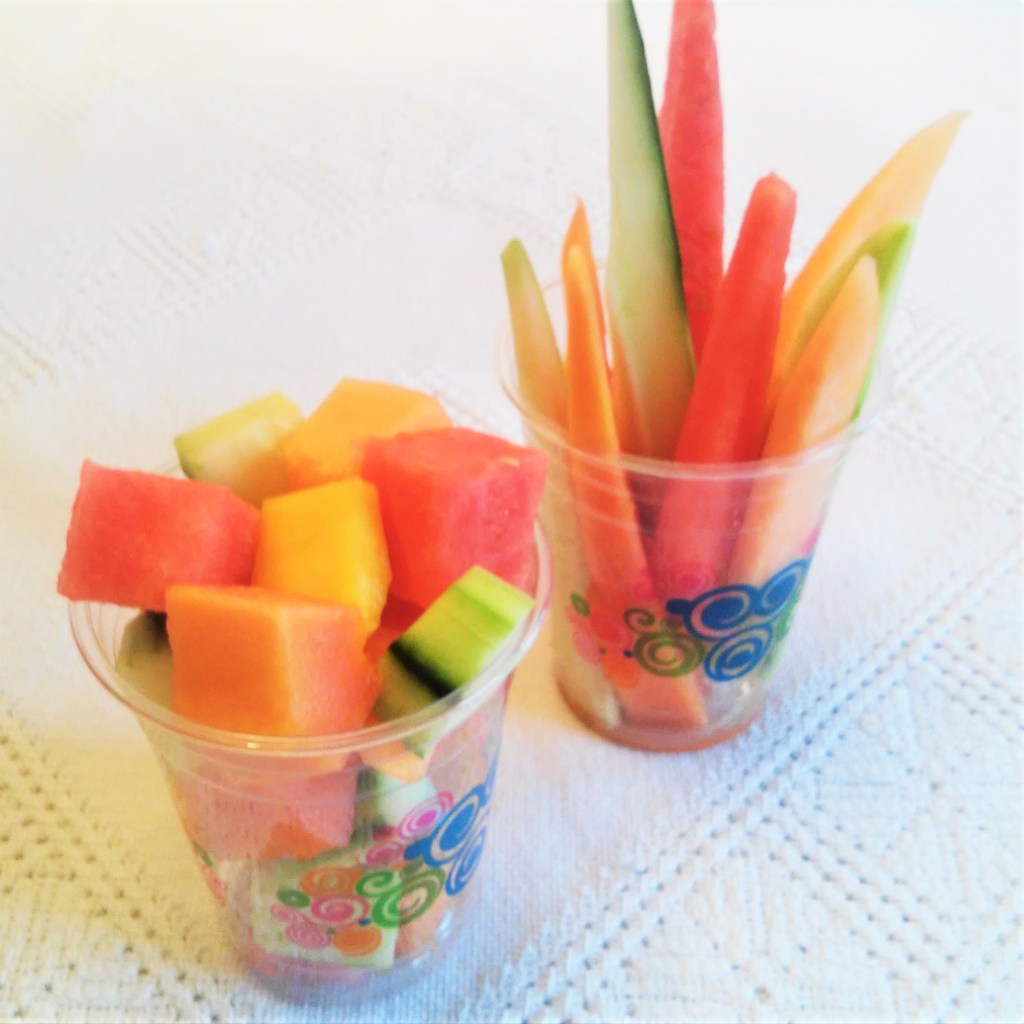
Since I had just harvested the very first kohlrabi in my backyard, I wished to taste some raw first, so I decided to make an all-veggie cup, as a twist on pico de gallo (salad) and fruta picada.
Below is a picture of a freshly harvested kohlrabi plant from my garden:
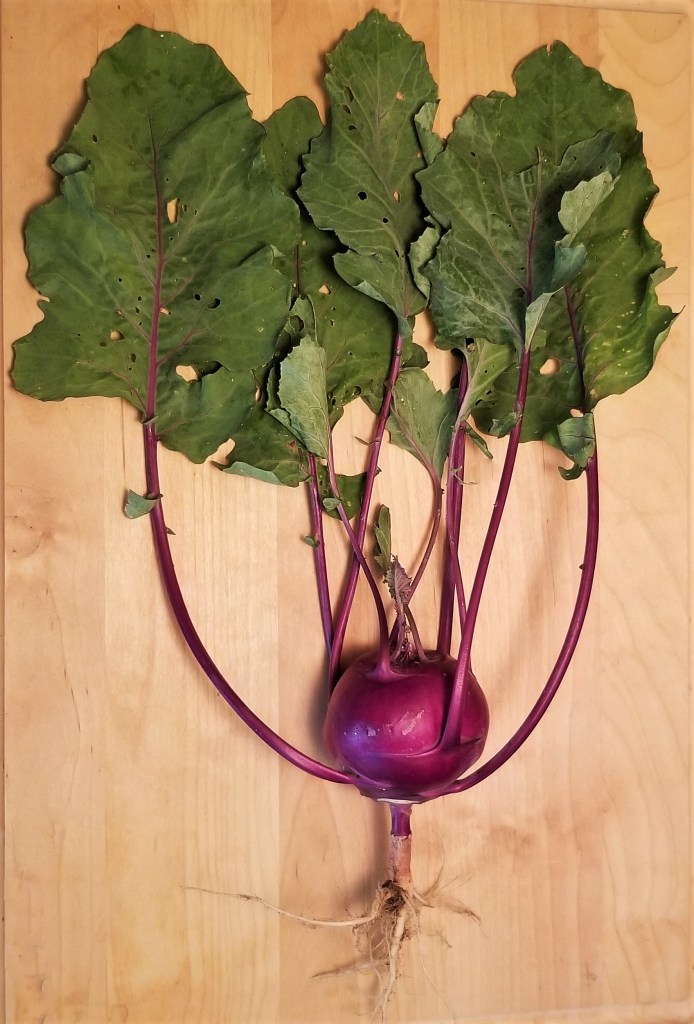
The leaves are edible, but since these already looked eaten up by bugs, I discarded them, along with the top and bottom, after washing thoroughly (photo below, left). I peeled with a paring knife, much like an apple; it was sad at first, to remove the pretty purple outer layer, but that revealed the pristine white flesh (photo below, right):
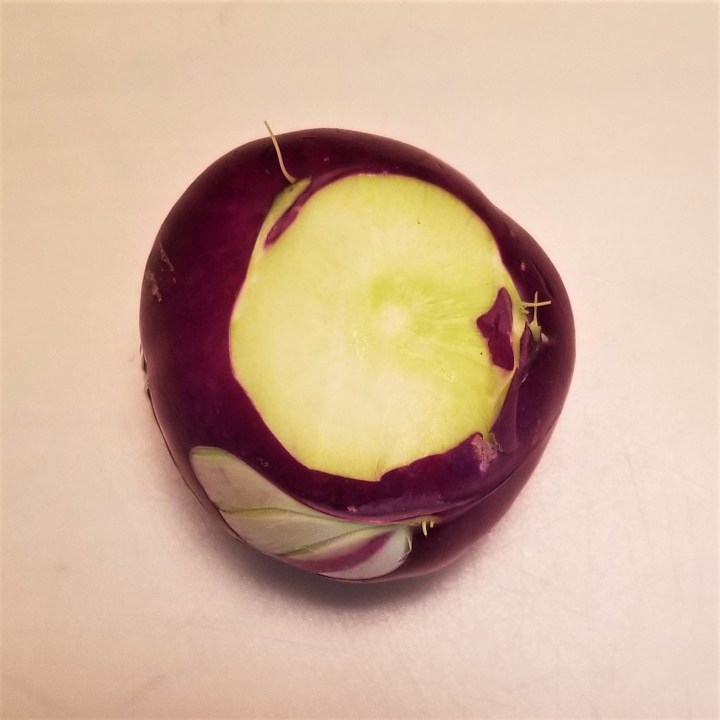
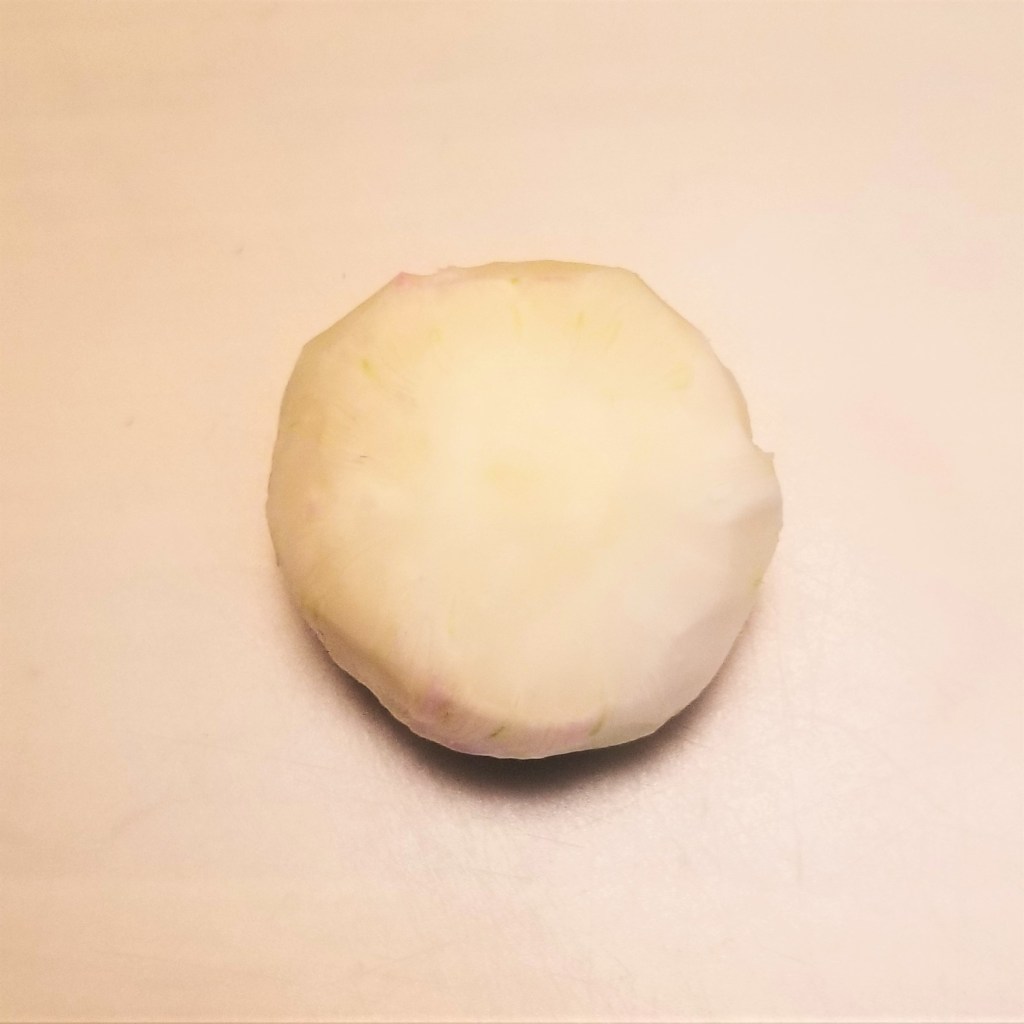
Veggie Cups with Kohlrabi –
Vasitos de verduras con colinabo
Ingredients (for two portions)
1 kohlrabi
1 large carrot
½ English cucumber
1 large lime
Ground chile and salt, or Tajín™ condiment (See * NOTE at the end)
Once the kohlrabi is peeled, as explained above, proceed to wash the lime, carrot and cucumber; peel carrot and cucumber, and slice lime in half:
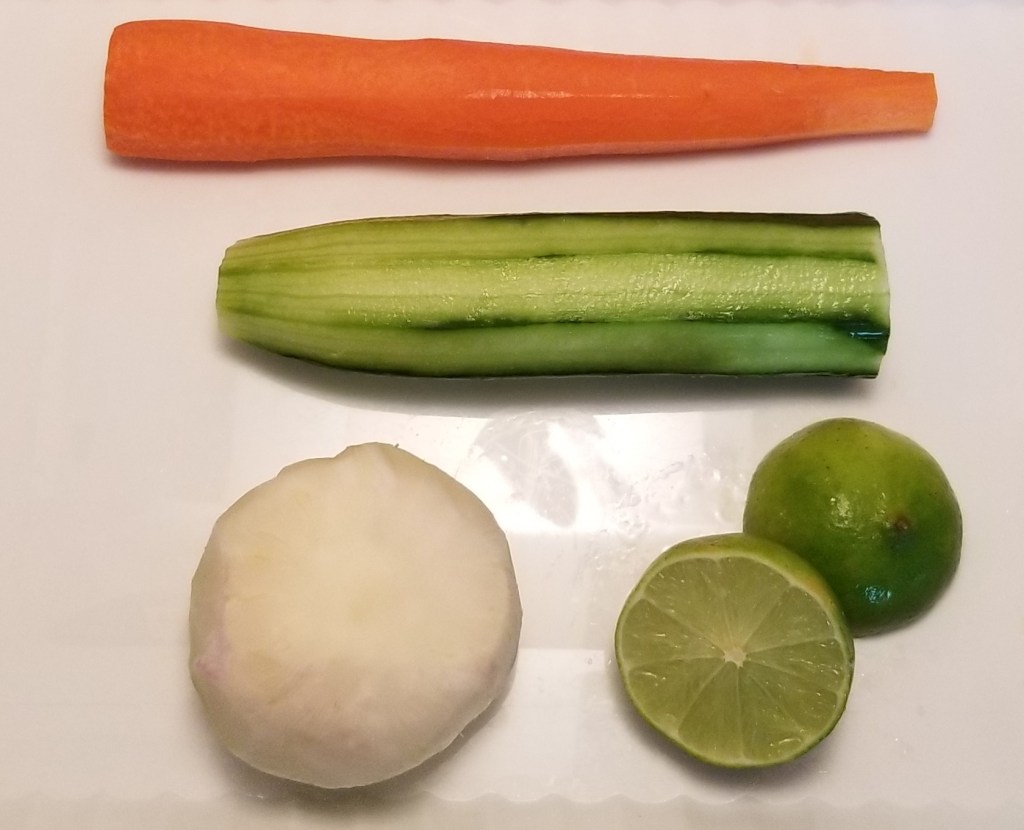
Slice kohlrabi into thin discs. Slice carrots lengthwise in half, then each half lengthwise again into thirds, for six long pieces; repeat with the cucumber, then slicing into thinner sticks, slightly in diagonal, to achieve pointy tips:
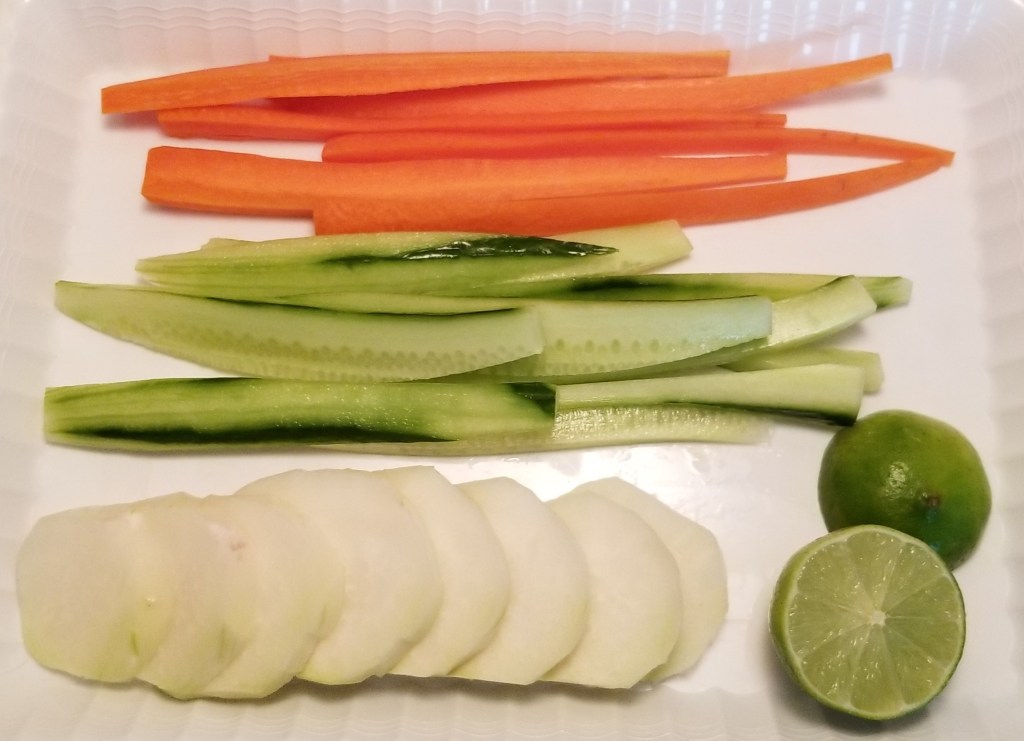
For each portion, arrange half the veggies in a clear plastic cup, leaving enough space to tuck in a half lime, and sprinkle with condiments, to taste:
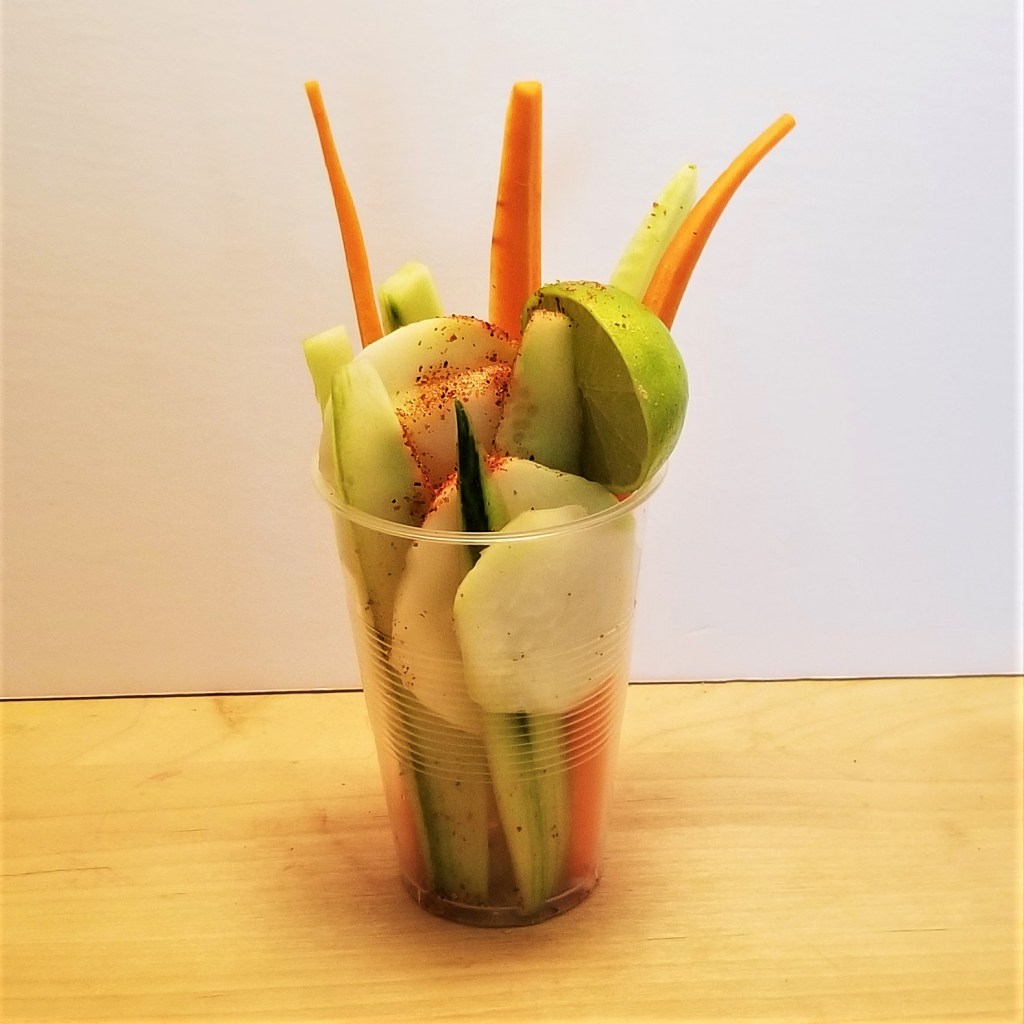
It was a great combination, and all the veggies were crunchy and refreshing. I had tried kohlrabi only pickled, so I knew I would like the flavour, but the extra crunchiness was a nice surprise. Both the taste and texture reminded me of a combination between broccoli hearts and a very sweet radish.
In terms of growing kohlrabi, it was easy, and the stems developed well in a little more than two months after sprouting. The purple skin is way too tough to eat, but maybe it could be used as a natural food colouring agent. That outer colour does not affect the flavour of the white flesh, but I think the purple globes in the garden are very decorative, looking even more alien and prettier than the common light green kohlrabi.
* NOTE: Every time I use ground chile, I feel like I have to include this information. Ground chile (or chili) is made by grinding dry hot red peppers, such as cayenne or piquín, and must not be confused with chili powder, which is often a mix of spices and hot peppers to condiment the American dish called “Chili”. Tajín™ is a Mexican condiment with ground chile, salt and citric acid, especially formulated to top Mexican snacks, such as fresh veggies and fruit:

** For example, “Frida’s Fiestas, Recipes and Reminiscences of Life with Frida Kahlo” by Guadalupe Rivera and Marie-Pierre Colle; Clarkson Potter/Publishers, Random House, New York, 1994. “Pico de Gallo”: p. 184 (photo) and p. 192 (recipe).
I am sharing my recipe at Over the Moon #233, graciously hosted by Bev @ Eclectic Red Barn, and Marilyn @ Marilyn’s Treats. Special thanks to Bev, for featuring my recipe for Mantecadas at her party.








That looks very fresh and crunchy. We get kohlrabi here only during winters.
LikeLike
Yes, it needs relatively cool weather to thrive. I might try growing some in late summer, for a fall crop.
LikeLiked by 1 person
It certainly looks the part, but….raw vegetables????? 🤣🤣🤣
LikeLike
Delicious with lime juice and Tajín (or powdered chile and salt). And good for yo, too! Believe it or not, when I was in grade school, instead of bake sales, the older students sold these cups and bags of pop corn, and we kids loved them. 😁
LikeLiked by 1 person
How is it that you manage to make everything look so scrumptious? Irene, you have to go into business of some sort—cookbook, restaurant, something.
LikeLiked by 1 person
😄 yeah, Mr. Bump UK was commenting on how the recipe is just raw veggies but “they look the part”. I have definitely started working on the cookbook with recipe selection; thank you so much for the encouragement, Sue, you are so kind!
LikeLiked by 2 people
I’ll second that you could definitely sell a cookbook with all the wonderful recipes and photos you’ve shared on this blog. Just do it.😊
LikeLiked by 1 person
Thank you so much, Eilene, I hope it happens!😁
LikeLiked by 1 person
Look so delicious 😋😋
LikeLike
That sounds like a great snack for a hot day, Irene. Congrats on growing that kohlrabi. I’m using your garden as a guide as to what I might be able to successfully grow here. Never thought of having chili with fruit salad. I must try it in summer. Also thanks for the info on the difference between ground chili and chili powder.
LikeLike
Thank you so much, Tracy! I was thinking of my Southern hemisphere friends, so I am going to post a recipe for sort of a stew with kohlrabi. Is it a common vegetable in Australia?
LikeLiked by 1 person
I’ve never actually had it before, Irene. I will be brave next time I see it and buy some. I have lots of problems with the carbs in potatoes. Maybe I could substitute with kohlrabi?
LikeLike
It is surprisingly sweet and tasty. If you like broccoli slaw/hearts, you will like kohlrabi. Just make sure to peel all the tough skin. I have never tried it cooked, I will report soon on that.
LikeLiked by 1 person
I do like broccoli. 🙂
LikeLiked by 1 person
So it turns out that pico de gallo is exactly like my favourite beach food: all the way from India to Vietnam. Cut slices of anything that you can eat without cooking, and splash chili, lime, and salt on it. My favourites are pineapple, guava, and sour, unripe, mango. Perfect in summer and the monsoon. That’s what a shared world culture tastes like!
LikeLike
I am always amazed by the similarities you point out between Mexican/Latin American and Indian/South Asian food and culture. We share spices and chiles, street food, and your favourite beach snack is a good example of our shared world culture, with pineapple, guava and chili from the Americas, and mango and limes from South Asia. Do you have a special name for that snack? Pico de gallo is mostly the salsa now, so the fruit salad is called fruta picada (chopped fruit) or vasitos de fruta (little fruit cups).
LikeLiked by 1 person
I don’t think we have a name for this kind of combination. Maybe further east, I don’t know.
LikeLiked by 1 person
********************************************************
Thank you for sharing at #OverTheMoon. Pinned and shared. Have a lovely week. I hope to see you at next week’s party too! Please stay safe and healthy. Come party with us at Over The Moon! Catapult your content Over The Moon! @marilyn_lesniak @EclecticRedBarn
********************************************************
LikeLiked by 1 person